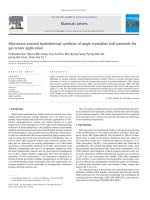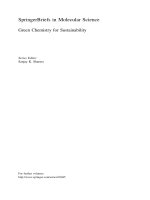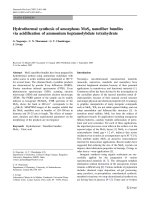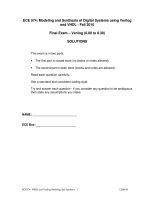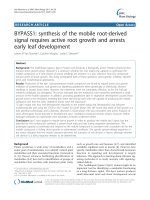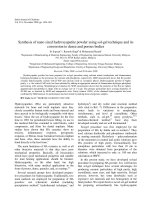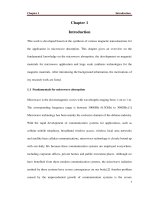Synthesis of graft copolymer of kappa-carrageenan using microwave energy and studies of swelling capacity, flocculation properties, and preliminary acute toxicity
Bạn đang xem bản rút gọn của tài liệu. Xem và tải ngay bản đầy đủ của tài liệu tại đây (4.85 MB, 13 trang )
Turk J Chem
(2016) 40: 283 295
ă ITAK
c TUB
Turkish Journal of Chemistry
/>
doi:10.3906/kim-1503-16
Research Article
Synthesis of graft copolymer of kappa-carrageenan using microwave energy and
studies of swelling capacity, flocculation properties, and preliminary acute toxicity
1
Tapan Kumar GIRI1,∗, Minakshi PRADHAN2 , Dulal Krishna TRIPATHI2
NSHM College of Pharmaceutical Technology, NSHM Knowledge Campus, Kolkata Group of Institutions,
Kolkata, West Bengal, India
2
Rungta College of Pharmaceutical Sciences and Research, Kurud, Bhilai, India
Received: 05.03.2015
•
Accepted/Published Online: 25.08.2015
•
Final Version: 02.03.2016
Abstract: Grafting of acrylamide (AAm) onto kappa-carrageenan (KC) was carried out using microwave irradiation in
the presence of ammonium persulfate (APS) as initiator. The effect of reaction variables including the concentration of
APS, AAm, and KC; time duration; and microwave power was studied. Fourier transform infrared spectroscopy (FT-IR),
X-ray diffraction (XRD), differential scanning calorimetry (DSC), and scanning electron microscopy (SEM) were carried
out to characterize the graft copolymer. The graft copolymer possesses slightly sensitive activities to external pH and
shows reversible on–off switching swelling characteristics. Flocculation efficacy of the graft copolymer was studied in
coal fine suspension toward potential application as a flocculent. The acute oral toxicity study of the graft copolymer
was evaluated as per OECD guidelines. Mice administered the graft copolymer did not show anomalous behavior during
the 14-day study. No mortality was observed during the 14 days following treatment with the graft copolymer.
Key words: Grafting, pH-sensitive, biopolymer, grafting, swelling, toxicity
1. Introduction
Green chemistry, also called sustainable chemistry, minimizes the use of nonrenewable resources and organic
solvents, the creation of toxic secondary products, the utilization of energy, and the emission of gases. 1,2 One
of the most attractive approaches in green chemistry is employing microwave energy for conducting chemical
transformations. Reduction of reaction times from days and hours to minutes and seconds, higher chemical
yields, and limited generation of byproducts make the microwave method better than conventional methods. 3
Graft copolymerization of natural polysaccharides is a vital resource for developing advanced materials as it can
improve the functional properties of natural polysaccharides. 4 The best method of graft copolymer synthesis
is by use of microwave radiation to produce free radical sites on the backbone polymer. Microwave-based
graft copolymer synthesis is classified into two types, i.e. microwave-initiated synthesis and microwave-assisted
synthesis. 5 Carrageenan is a natural polysaccharide obtained from edible red seaweeds. 6 It is traditionally
identified by a Greek prefix. The three commercial most significant carrageenans are iota, kappa and lambda
carrageenan. They differ in the number and location of sulfate units and anhydro bridges. Kappa carrageenan
(KC) is used in a variety of commercial applications as a gelling, thickening, and stabilizing agent, particularly
in food products. 7,8 KC is also used in experimental medicine, pharmaceutical formulations, cosmetics, and
industrial applications. KC has one sulfate and one anhydro 9 bridge per every two galactose units (Figure 1).
∗ Correspondence:
tapan ju01@rediffmail.com
283
GIRI et al./Turk J Chem
It suffers from certain drawbacks like inadequate control over the swelling properties, easier susceptibility to
microbial attack, and biodegradability, which limit its uses. Several chemical modifications have been anticipated
to modulate the physico-chemical properties of carrageenans. Its physico-chemical properties can be increased
because the additional properties of monomer are superimposed onto the polymeric backbone of KC.
Figure 1. Chemical structure of kappa-carrageenan.
Carboxymethylated KC was developed as a carrier for intestinal targeted delivery of bioactive molecules
and wound healing matrix possessing anticoagulant and antibacterial properties. 10−12 A graft copolymer of KC
and N, N -dimethylacrylamide was prepared by free radical polymerization for the management of coal mine
wastewater. 13 Another graft copolymer of KC and N -vinyl formamide was prepared by free radical initiation
for the treatment of coal mine wastewater. 9 Reports on the grafting of KC with acrylamide using APS are
limited in number. Therefore, in the light of versatile applications of KC and its derivatives, this work was
carried out with the aim to tailor KC-based hybrid materials by grafting acrylamide using APS as initiator. The
optimum grafting conditions were obtained, and studies were carried out on swelling capacity, acute toxicity,
and flocculation ability.
2. Results and discussion
Acrylamide-grafted KC was synthesized by microwave-assisted method. Sulfate ion radicals (SO −∗
4 ) are generated from the APS by the reduction of one electron under microwave. The SO −∗
radicals abstract hydrogen
4
atoms from KC molecules producing KC macroradicals. The monomer molecules, which are in close vicinity to
reaction sites, become acceptors of KC macro radicals, resulting in chain initiation and thereafter themselves
become free radical donors to adjacent molecules, leading to propagation. These grafted chains are ended by
combination to give graft copolymer. The scheme of free radical reaction is given in Figure 2.
2.1. Characterization of graft copolymer
Figure 3 shows the FTIR spectra of acrylamide, KC, and the grafted copolymer. Acrylamide presented bands
(Figure 3a) at 3352.52 cm −1 and 3180.61 cm −1 , associated with asymmetric and symmetrical stretching of
the NH bond, respectively. The band shown at 2812.21 cm −1 represents typical stretching of CH bonds.
Typical bands of amide are seen at 1674.21 cm −1 and 1612.49 cm −1 , the first related to stretching of the
C=O group (amide I) and the second to angular deformity of the NH 2 group (amide II). The band at 1429.25
cm −1 was attributed to CN bond stretching. The spectra of acrylamide are consistent with those presented
in the literature. 14 At 3421.71 cm −1 , the broad band is ascribed to the stretching of –OH groups of KC
(Figure 3b). The absorption band at 2906.72 cm −1 results from the stretching frequency of CH 2 groups. The
peaks observed at 846.75, 927.76, 1037.70, and 1267.23 cm −1 are due to D-galactose-4-sulfate, 3,6-anhydroD-galactose, glycosidic linkage, and ester sulfate stretching, respectively. 15 Some differences were observed in
the spectra of the graft copolymer compared to KC. The graft copolymerization is further confirmed by the
284
GIRI et al./Turk J Chem
Figure 2. A proposed mechanism for synthesis of polyacrylamide-grafted KC by microwave-assisted method.
Figure 3. FTIR spectra of (a) acrylamide, (b) KC, (c) graft copolymer (% G = 362.16).
285
GIRI et al./Turk J Chem
characteristic absorption band of amide I at 1664.56 cm −1 due to > C=O stretching vibration, amide II at
1611.75 cm −1 due to NH 2 , and at 1450.46 cm −1 due to –CN stretching vibration of monomer molecule (Figure
3c). The CH stretching band of KC and acrylamide overlap to give CH stretching at 2935.65 cm −1 .
An endothermic peak at 56.38 ◦ C and an exothermic peak at 216.43 ◦ C are recorded in the DSC curve
of the KC (Figure 4a). The first endothermic peak arises because of a small amount of absorbed moisture. The
exothermic peak at 216.43 ◦ C is attributed to polysaccharide degradation. 13
In the DSC curve of acrylamide, two endothermic peaks are observed (Figure 4b). The first sharp
endothermic peak, at 95.4 ◦ C, may be due to the melting of acrylamide. The second peak, at 183.89 ◦ C, is
due to decomposition of acrylamide by the release of ammonia. It has been reported that acrylamide degrades
in the temperature range of 175–300 ◦ C by the release of ammonia. 16
183.89
95.40
0
50
100
150
216.43
Heat flow endo down
Heat flow endo down
b
200
250
300
a
56.38
50
0
100
Temperature (°C)
150
200
250
300
Temperature (°C)
222
255.47
Heat flow endo down
c
230.03
37.99
0
50
100
150
200
250
278.02
300
Temperature (°C)
Figure 4. DSC thermogram of (a) KC, (b) acrylamide, (c) graft copolymer (% G = 362.16).
Two exothermic peaks are observed in the DSC of grafted copolymer at 222
◦
C and 255.47
◦
C (Figure
◦
4c). The KC rapidly thermally decomposes by a one-step process at 216.43 C, but the graft copolymer
enhances the thermal decomposition temperature and exhibits two-step thermal decomposition at 222 ◦ C and
255.47 ◦ C. The exothermic peaks of the polysaccharide could be changed after grafting reaction due to the
increased interaction between the main chains of polysaccharide and the grafted polymer chains. 17
The diffractogram of acrylamide (Figure 5a) showed the crystalline nature. 18 The diffractogram of KC
(Figure 5b) also showed a small amount of crystallinity. In the XRD spectrum of graft copolymer (Figure 5c),
there is no significant peak of crystallinity as demonstrated by a broad halo. It illustrated that on grafting the
crystallinity of acrylamide and KC disappeared. Similar observations were observed in the grafting of xanthan
gum and acrylamide. 18
Acrylamide (Figure 6a) morphology is changed drastically when grafted onto KC. The surface morphology
of KC (Figure 6b) before grafting shows a granular structure, which changed to fibrillar form after grafting
(Figure 6c). Thus comparison of these figures reveals that grafting took place.
286
Intencity (CPS)
Intencity (CPS)
GIRI et al./Turk J Chem
a
10
20
30
40
Theta (degree)
50
60
10
20
30
40
Theta (degree)
50
0
30
40
Theta (degree)
50
60
c
Intencity (CPS)
0
b
0
10
20
60
Figure 5. XRD spectrum of (a) acrylamide, (b) KC, (c) graft polymer (% G = 362.16).
Figure 6. Scanning electron micrograph of (a) acrylamide, (b) KC, (c) graft polymer (% G = 362.16).
287
GIRI et al./Turk J Chem
2.2. Determination of optimum reaction conditions
The grafting of acrylamide on KC backbone in the presence of catalyst (APS) occurred by free radical reaction
mechanism. The optimum reaction condition was obtained by varying the concentration of APS, KC, and AAm,
along with reaction time and microwave power and their effects on grafting parameters were studied.
2.2.1. Effect of APS concentration
The concentration of initiator (APS) was varied from 0.1 × 10 −3 mol/L to 40 × 10 −3 mol/L, keeping the
concentration of all other reagents fixed. It was observed that % G and % GE increase on increasing the
concentration of APS from 0.1 × 10 −3 mol/L to 20 × 10 −3 mol/L but outside this cited range, the values of
these parameters decreased (Figure 7). The increase in grafting parameters may be ascribed to the increase in
the number of primary free radicals that attack the KC molecules, creating more active sites to which monomer
addition takes place. Further, a relatively high concentration of the initiator may cause a reduction in grafting
due to an increase in the number of KC radicals terminated prior to AAm addition. This is in agreement with
the results obtained in the grafting of acrylonitrile onto sodium alginate. 19 Therefore, the optimum initiator
concentration is 20 × 10 −3 mol/L.
2.2.2. Effect of AAm concentration
The effect of monomer concentration on grafting parameters was studied by varying the concentration of
acrylamide (from 14.28 to 114.28 g/L), keeping other variables fixed. It was observed that % G and %
GE increase with the increasing concentration of AAm, but beyond 100 g/L % G increases, while % GE
decreases. The early increasing trend of % G and % GE may be due to availability of additional monomer for
copolymerization; however, on increasing concentration >100 g/L, % GE decreased as more homopolymerization
takes place due to an increase in the monomer to KC ratio (Figure 8). Even though the absolute amount of
grafted polymer increases, it decreases relative to the fast increase in monomer. A similar observation was also
reported previously. 20 Therefore, the optimum monomer concentration is 100 g/L.
100
400
a
100
1600
90
350
1400
95
1200
90
80
300
1000
%G
%GE
40
%G
%GE
%G
50
200
85
60
250
800
%GE
70
80
600
75
30
150
20
100
400
70
200
10
65
0
50
0
–3
Concentration of APS x 10 (mol/L)
Figure 7. Effect of initiator (APS) concentration keeping
0
20
40
60
80
100
120
AAm concentration (g/L)
other variables constant at [KC] = 7.143 g/L; [AAm] =
Figure 8. Effect of AAm concentration keeping other
variables constant at [KC] = 7.143 g/L; [APS] = 20 ×
28.57 g/L; reaction volume = 35 mL; reaction time = 120
s, microwave power = 800 W.
10 −3 mol/L; reaction volume = 35 mL; reaction time =
120 s, microwave power = 800 W.
288
GIRI et al./Turk J Chem
2.2.3. Effect of exposure time
The effect of exposure time was monitored by irradiating the reaction mixture for various times ranging from
30 to 180 s, keeping the other variables fixed. It has been observed that % G and % GE increase on increasing
the time from 30 to 120 s. On further increasing the time, grafting parameters show a decreasing trend (Figure
9). This could be ascribed to the availability of extra microwave energy at higher exposure time; however,
on prolonged exposure (after 120 s), the grafting parameter decreases, possibly due to some decomposition of
the graft copolymer. A similar observation was also reported previously. 21 Therefore, the optimum time for
grafting is 120 s.
2.2.4. Effect of microwave power
The effect of microwave power was monitored by irradiating the reaction mixture for various powers ranging
from 480 to 800 W, keeping the other variables fixed. % G and % GE increase with increasing microwave power
up to 800 W; this may be due to greater availability of microwave energy at high microwave power, causing
production of more monomer and macroradicals, resulting in high percentage grafting (Figure 10). Moreover,
grafting parameters increase extremely after 650 W microwave power, possibly due to the greater availability
of microwave energy, which induces a very rapid decomposition of the initiators into radicals.
Singh et al. have made a similar observation. 22 Therefore, the optimum power for grafting is 800 W.
130
400
90
500
d
120
%G
80
110
%GE
450
100
70
300
%GE
50
250
90
40
%G
60
%GE
%G
%G
400
80
70
350
60
200
30
150
20
40
60
20
80 100 120 140 160 180 200
Exposure time (s)
%GE
350
50
300
450
500
550
600
650
700
750
800
40
850
Microwave power (W)
Figure 9. Effect of exposure time keeping other variables
Figure 10. Effect of microwave power keeping other vari-
constant at [KC] = 7.143 g/L; [APS] = 20 × 10 −3 mol/L;
ables constant at [KC] = 7.143 g/L; [APS] = 20 × 10 −3
[AAm] = 100 g/L; reaction volume = 35 mL, microwave
power = 800 W.
mol/L; [AAm] = 100 g/L; reaction volume = 35 mL, time
= 120 s.
2.2.5. Effect of KC concentration
The effect of KC concentration on grafting parameters was studied by varying the concentration of KC from
3.57 g/L to 14.28 g/L, keeping other variables constant (Figure 11). It was observed that the % G decreases
gradually with the increased KC concentration. However, % GE increases up to concentration 7.143 g/L and
afterward declines. This may be because an increase in backbone concentration can make more monomers and
initiators easily approachable to the surface of KC and produce more grafted site chains, which cause % GE
to increase. The decreasing trend may be due to the decrease in the ratio of monomer amount per KC chain
289
GIRI et al./Turk J Chem
at higher KC concentrations. A similar observation was reported previously. 23 Therefore, the optimum KC
concentration is 7.143 g/L.
2.3. Swelling study
2.3.1. Effect of pH on swelling
Equilibrium swelling for the graft copolymer was studied at various pH solutions ranging from 2.0 to 12.0. In
Figure 12, the dependence of the equilibrium swelling of the graft copolymer is characterized by a curve with
two maxima at pH 3.0 and 8.0. Under acidic conditions, the swelling is controlled mainly by NH 2 groups on the
acrylamide components. It is a weak base with an intrinsic pKa of about 4.9 and so it gets protonated and the
increased charge density on the polymer should enhance the osmotic pressure inside the gel particles. However,
under a very acidic condition (pH < 3), a screening effect of the counter ion, i.e. Cl − , shields the charge of the
ammonium cations and prevents an efficient repulsion. At higher pH (pH = 8), some of the sulfonate groups
are ionized and the electrostatic repulsion causes an enhancement of the swelling capacity. The swelling loss in
the highly basic solutions (pH > 8) is due to the “charge screening effect” of excess Na in the swelling media,
which shields the sulfonate anions and prevents effective anion–anion repulsion. 24
92
700
90
600
%G
88
%GE
86
3
84
2.5
82
300
80
78
200
76
100
2
4
6
8
10
12
Concentration of KC (g/L)
14
74
16
Figure 11. Effect of KC concentration keeping other variables constant at [APS] = 20 × 10
−3
mol/L; [AAm] = 100
Swelling ratio
400
%GE
%G
500
2
1.5
1
0.5
0
0
2
4
6
8
10
12
pH
Figure 12. Influence of pH values on swelling (unit of
swelling ratio is g H 2 O/g copolymer).
g/L; reaction volume = 35 mL, time = 120 s, microwave
power = 800 W.
2.3.2. pH sensitivity (pulsatile swelling)
The synthesized graft copolymer shows different swelling behavior in acidic and basic pH solutions. We
investigated the reversible swelling/deswelling performance of the graft copolymer in buffer solutions with pH
2.0 and 8.0 for 30-min time intervals (Figure 13). At pH 8.0 the graft copolymer swells due to anion–anion
repulsive forces, while at pH 2.0 it shrinks within a few minutes due to the charge screening effect.
2.3.3. Effect of salt on swelling
The swelling capacities of graft copolymer in salt solutions are decreased compared with the value measured in
distilled water (Figure 14). Generally, the swelling capacity of ionic polymer in salt solutions was considerably
290
GIRI et al./Turk J Chem
decreased compared to the absorbency values in distilled water. This undesired swelling loss has been ascribed
to the “charge screening effect” of the cations, leading to the reduction in osmotic pressure, the driving force for
swelling between the gel and the aqueous phases. When the polymer is in salt solution (for example, NaCl), the
development of osmotic pressure is much lower because the external solution contains Na + and Cl − . Therefore,
the swelling is considerably reduced. In the case of salt solutions with multivalent cations (CaCl 2 , AlCl 3 ), ionic
cross-linking at the surface of the particles causes a substantial decrease in swelling capacity. 25 The swelling of
the graft copolymer in the studied salt solution from high to low is NaCl > CaCl 2 > AlCl 3 .
3.5
Swelling ratio
3
3
Swelling ratio
2.5
2
1.5
1
pH 8
pH 8
pH 2
pH 2
NaCl
CaCl2
AlCl3
2.5
2
1.5
1
0.5
0.5
0
0
0
20
40
60
80
100
120
Time (min)
0
0.2
0.4 0.6 0.8
1
1.2
Salt concentration (mol/L)
1.4
1.6
Figure 13. Pulsatile swelling (unit of swelling ratio is g
Figure 14. Influence of saline solution on swelling (unit
H 2 O/g copolymer).
of swelling ratio is g H 2 O/g copolymer).
2.4. Flocculation performance
Plots of supernatant turbidity versus polymer dosage for coking and noncoking coals are given in Figure 15.
It is observed that the graft copolymer shows superior performance with low turbidity than KC itself. This is
because of the presence of the longer branches of polyacrylamide chains on the rigid polysaccharide backbone in
the case of graft copolymers, being able to approach better the contaminant coal particles. 26 The disparity in
turbidity value in coking coal and noncoking coal in coal suspension is due to the difference in negative charge
density, which is higher in noncoking coal in aqueous solution, thus giving a better flocculation performance. 27
2.5. Acute toxicity study
The acute effect of the graft copolymer as a single oral dose at 300 or 2000 mg/kg did not produce any mortality
nor alter the behavior patterns of the mice throughout the observation period. Therefore, the LD 50 value for
oral administration of the graft copolymer in mice exceeds 2000 mg/kg. As per the globally harmonized system
(GHS) if LD 50 is greater than the 2000 mg/kg dose then the test product will fall under “category 5” and the
toxicity rating will be “zero”.
A novel polymeric material was developed by grafting acrylamide onto KC backbone by microwaveassisted method. Various macromolecular characterizations prove that graft copolymerization does take place.
The graft copolymer exhibited excellent pH-sensitive behavior and on–off switching swelling characteristics with
better reversibility. The different swelling behavior was observed in multivalence saline solution. The acrylamide
is toxic but from the toxicity study it is revealed that there is no morbidity or mortality at a dose of 2000 mg/kg
291
GIRI et al./Turk J Chem
body weight of graft copolymer. Further, the synthesized copolymer found potential application as an efficient
flocculant.
40
Turbidity (N.T.U)
30
20
KC (coking coal)
10
KC (noncoking coal)
graft copolymer (coking coal)
graft copolymer (noncoking coal)
0
0
5
Flocculent dose (ppm)
10
Figure 15. Effect of polymer dosage on turbidity for coking coal and noncoking coal.
3. Experimental
3.1. Materials
KC was procured from Victory Essence Mart (Bangalore, India). AAm, APS, and methanol were purchased
from Loba Chemie, Mumbai, India. The other reagents were all of analytical grade and used as received.
3.2. Synthesis of graft copolymer
The requisite quantity of KC was dispersed in 25 mL of water. Then 5 mL of acrylamide solution in water was
added to the KC dispersion and stirred for 1 h. Next 5 mL of APS solution in water was added to the above
dispersion. The dispersion so obtained was irradiated by microwave in a domestic microwave oven (20STP21,
MIRC Electronics Ltd., Mumbai, India) for different times and different powers to prepare various batches
of graft copolymer. After completion of the reaction, the reaction mixture was allowed to cool to ambient
temperature and precipitated by pouring the reaction mixture into the methanol and kept aside overnight. It
was then dried in an oven. Homopolymer was removed from the graft copolymer synthesized as above by solvent
extraction using a formamide–acetic acid mixture (1:1 by volume). 28 After that the product was filtered and
washed with a methanol:water (80:20) mixture. Then the product was dried in an oven at 45
weight.
◦
C to constant
Percentage grafting (% G) and percentage grafting efficiency (% GE) were calculated in the following
manner:
%G =
(Weight of graft copolymer − Weight of polysaccharide )
×100
Weight of polysaccharide
(1)
(Weight of graft copolymer − Weight of polysaccharide)
×100
Weight of acrylamide
(2)
% GE =
292
GIRI et al./Turk J Chem
3.3. Fourier transform infrared spectroscopy
The samples were subjected to FT-IR spectroscopy in a Fourier transform infrared spectrophotometer (Prestige21, Shimatzu, Japan). The samples were scanned between 400 and 4000 cm −1 . 29
3.4. Differential scanning calorimetry
Differential scanning calorimetric thermograms of KC, acrylamide, and KC-graft-acrylamide were recorded using
a differential scanning calorimeter (Pyris Diamond TG/DTA, PerkinElmer, Singapore) in the temperature range
from 0 to 300 ◦ C at a heating rate of 10 ◦ C/min under nitrogen atmosphere (150 mL/min). 30
3.5. X-ray diffractometry
X-ray diffractograms of KC, acrylamide, and KC-graft-acrylamide were recorded employing an X-ray diffractometer (Ultima-III, Rigaku, Japan) using copper radiation in the differential angle range of 0–60 ◦ (2 θ). 31
3.6. Scanning electron microscopy
Scanning electron micrographs of KC, acrylamide, and KC-graft-acrylamide were taken using scanning electron
microscopy (JSM6360, JEOL, UK).
3.7. Swelling studies
The swelling behavior of the KC-graft-acrylamide was determined by the tea bag method. About 200 mg of
sample was added to a small bag made of nylon (100 mesh screen). Then the bag was completely immersed in
the swelling medium of different pHs (100 mL) at room temperature for 3 h to reach the swelling equilibrium.
It was removed from the swelling medium and hung up for 15 min to remove the excess fluid and weighed. The
swelling ratio was determined using the following equation 32 : swelling ratio = (weight of swollen polymer –
weight of dry polymer)/weight of dry polymer. Swelling ratio values are the gram of water absorbed by one
gram of dry copolymer and the unit is g H 2 O/g copolymer.
3.7.1. Swelling in different pH
pH-dependent swelling was performed at various pHs ranging from 2 to 12. The various solutions were adjusted
to the preferred pH value by addition of diluted HCl or NaOH to distilled water.
3.7.2. Pulsatile swelling
The pH responsive behavior of the graft copolymer was confirmed by pulsatile swelling study. The study was
conducted in 100-mL solutions of pH 2.0 and pH 8.0 by mass measurement. The pH of the external medium
was changed alternatively between 2.0 and 8.0.
3.7.3. Effect of salt solution on swelling
The effect of different salt solutions (NaCl, CaCl 2 , and AlCl 3 ) with different concentrations on the swelling
behavior of the graft copolymer was investigated. Ionic strengths of the swelling solutions were varied from 0.02
mol/L to 1.6 mol/L.
293
GIRI et al./Turk J Chem
3.8. Flocculation test
First 500 mL of 1 wt % coal suspension was taken in a dissolution rate test apparatus (TDT-08L, Electro lab,
Mumbai, India). Under a low stirring condition, the requisite quantity of polymer solution was added to make
a fixed dose with respect to suspension volume. After the addition of polymer solution, the suspension was
stirred at 50 rpm for 15 min. The flocks were allowed to settle down for half an hour. Clean supernatant liquid
was withdrawn from a depth of 1.0 cm and its turbidity was measured using a digital nephelometer (Model-341,
EI lab, Himachal Pradesh, India) to express the turbidity in nephelometric unit (N.T.U.).
3.9. Acute toxicity study
Six nulliparous and nonpregnant 8-week-old female mice (Swiss albino strain) were used for this study. The animals were housed in a well-ventilated room with a constant temperature of 22 ± 2 ◦ C, relative humidity of 40%–
70%, and illumination of 12 h light/dark cycles. Potable water and standardized diet were provided ad libitum.
The protocol of the study was approved by the Animal Ethics Committee of Rungta College of Pharmaceutical
Sciences and Research, Bhilai, India (CPCSEA approval No: 1189/RCPSR/12/03/PO/a/08/CPCSEA). The
study design followed the OECD guidelines 425 (OECD, 2008). A single dose of 300 mg/kg and 2000 mg/kg
body weight of graft copolymer was administered by gavages using a stomach tube to the first and second
animals. The dose of 2000 mg/kg body weight was administered to the remaining four animals after survival
of the first two animals. The general behavior of the mice was continuously monitored for 4 h after dosing,
periodically during the first 24 h, and then daily thereafter, for a total of 14 days. The mortality was evaluated
by visible observation and reported accordingly.
References
1. Tucker, J. L. Org. Process. Res. Dev. 2010, 14, 328-331.
2. Erdmenger, T.; Guerro-Sanchez, C.; Vitz, J.; Hoogenboom, R.; Schubert, U. S. Chem. Soc. Rev. 2010, 39, 33173333.
3. Kappe, C. O. Angew. Chem. Ind. Ed. 2004, 43, 6250-6284.
4. Giri, T. K.; Thakur, D.; Alexander, A.; Ajazuddin; Badwaik, H.; Tripathi, M.; Tripathi, D. K. J. Mater. Sci.
Mater. Med. 2013, 24, 1179-1190.
5. Badwaik, H. R.; Giri, T. K.; Nakhate, K. T.; Kashyap, P.; Tripathi, D. K. Curr. Drug. Deliv. 2013, 10, 587-600.
6. Knutsen, S. H.; Myladobodski, D. E.; Larsen, B.; Usov, A. T. Botania. Marina. 1994, 37, 163-169.
7. Aguilan, J.; Dayrit, F.; Lebrilla, C.; Ninonuevo, M.; Zhang, J. J. Am. Soc. Mass. Spectrom. 2006, 17, 96-103.
8. Mondoza, W. G.; Montano, N. E.; Ganzon-Fortes, E. T.; Villanueva, R. D. J. Appl. Psychol. 2002, 14, 409-418.
9. Mishra, M. M.; Yadav, M.; Sand, A.; Tripathy, J.; Behari, K. Carbohydr. Polym. 2010, 80, 235-241.
10. Yagi, T.; Nagasawa, N.; Hiroki, A.; Tamada, J.; Aramilla, C. US Patent, 2010,US20100314580 A1.
11. Leong, K. H.; Chung, L. Y.; Noordin, M. I.; Mohamad, K.; Nishikawa, M.; Onuki, Y.; Morishta, M.; Takayama,
K. Carbohydr. Polym. 2011, 83, 1507-1515.
12. Fan, L.; Wang, L.; Gao, S.; Wu, P.; Li, M.; Xie, W.; Liu, S.; Wang, W. Carbohydr. Polym. 2011, 86, 1167-1174.
13. Mishra, D. K.; Tripathy, J.; Behari, K. Carbohydr. Polym. 2008, 71, 524-534.
14. Maia, A. M. S.; Silva, H. V. M.; Curti, P. S.; Balaban, R. C. Carbohydr. Polym. 2012, 90, 778-783.
15. Pourjavadi, A.; Harzandi, A. M.; Hosseinzadeh, H. Eur. Pomym. J. 2004, 40, 1363-1370.
16. Conley, R. T. In Thermal Stability of Polymers; Conley, R. T. Ed. Dekker: New York, NY, USA, 1970, pp. 254.
294
GIRI et al./Turk J Chem
17. Srivastava, A.; Behari, K. J. Appl. Polym. Sci. 2006, 100, 2480-2489.
18. Kumar, A.; Singh, K.; Ahuja, M. Carbohydr. Polym. 2009, 76, 261-267.
19. Shah, S. B.; Patel, C. P.; Trivedi, H. C. High. Perform. Polym. 1992, 4, 151-159.
20. Liu, Y.; Li, Y.; Yang, L.; Liu, Y.; Bai, L. Iran. Polym. J. 2005, 14, 457-463.
21. Giri, T. K.; Verma, P.; Tripathi, D. K. Adv. Compos. Mater. 2014, DOI: 10.1080/09243046.2014.906977.
22. Singh, A. V.; Nath, L. K.; Guha, M. Carbohydr. Polym. 2011, 86, 872-876.
23. Shah, S. B.; Patel, C. P.; Trivedi, H. C. Angew. Makromoi. Chem. 1994, 214, 75-79.
24. Lanthong, P.; Nuisin, R.; Kiatkamjornwong, S. Carbohydr. Polym. 2006, 66, 229-245.
25. Shi, X.; Wang, W.; Wang, A. J. Composite. Mater. 2011, 45, 2189-2198.
26. Deshmukh, S. R.; Singh, R. P.; Chaturvedi, P. N. J. Appl. Polym. Sci. 1985, 30, 4013-4018.
27. Tripathy, J.; Mishra, D. K.; Behari, K. Carbohydr. Polym. 2009, 75, 604-611.
28. Rani, G. U.; Mishra, S.; Sen, G.; Jha, U. Carbohydr. Polym. 2012, 90, 784-791.
29. Giri, T. K.; Sa, B. Pharmacology Pharmacy 2010, 1, 18-26.
30. Giri, T. K.; Verma, S.; Alexander, A.; Ajazuddin.; Badwaik, H.; Tripathy, M.; Tripathi, D. K. Farmacia 2013, 61,
533-550.
31. Giri, T. K.; Kumar, K.; Alexander, A.; Ajazuddin; Badwaik, H.; Tripathy, M.; Tripathi, D. K. Curr. Drug. Deliv.
2013, 10, 435-443.
32. Abd El-Rehim, H. A.; Hegazy EL-Sayed, A.; Ali, A. M. J. Appl. Polym. Sci. 2000, 76, 125–132.
295


